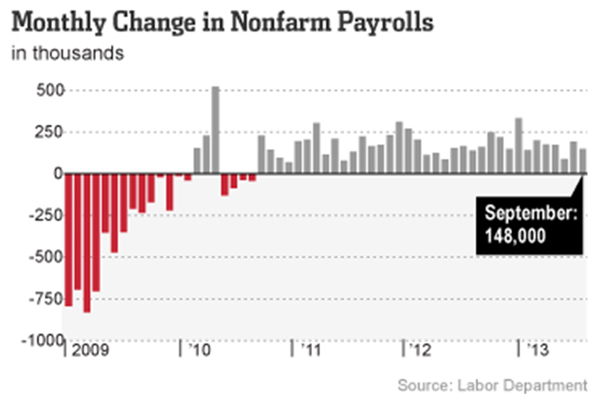October 22, 2013
September Unemployment Report
Unemployment Rate: 7.2 percent
Unemployed Americans: 11.3 million
“Real” Unemployment
- The “real” unemployment or U-6 rate is 13.6 percent for September 2013, a decrease of 0.1 percentage points. This is the total percentage of unemployed and underemployed workers.
- The “real” number of unemployed Americans is 21.5 million. These are people who are unemployed (11.3 million), want work but have stopped searching for a job (2.3 million), or are working part time because they can’t find full-time employment (7.9 million).
- Of note, data collection for today’s employment report was completed prior to the government shutdown.
Labor Force Participation
- The labor force participation rate is 63.2 percent, unchanged from last month, and the lowest rate in 35 years.
- If the labor force participation rate were the same as when President Obama took office, the unemployment rate would be 10.6 percent.
- The share of American adults with jobs in August was 58.6 percent, roughly the same for more than three years. This is approximately five percentage points below its prerecession peak.
- The number of long-term unemployed (27 weeks or more) spiked to 45 percent in April 2010 and again in March 2011 -- and is currently 36.9 percent of the unemployed. During the 1980s, when our country faced a similar recessionary period, the proportion of long-term unemployed never exceeded 27 percent.
- Concern has also been raised about the consistent number of Americans who are working part time for economic reasons. These people are working part time because their hours have been cut back or because they are unable to find a full-time position. This figure has averaged 8.0 million throughout 2013.
- There were 852,000 people in September categorized as discouraged workers, an increase of 50,000 from a year earlier. Discouraged workers are those who are not currently looking for work because they believe no jobs are available for them.
Employment
- The Department of Labor reported an unemployment rate of 7.2 percent for September 2013, down 0.1 percent from August. It also reported an increase of 148,000 nonfarm jobs -- weaker than expected – of which 126,000 were in the private sector. The last two months were revised for a combined increase of 9,000 jobs over what was previously reported. July employment figures were revised from 104,000 to 89,000 jobs created, and August figures were revised from 169,000 to 193,000 new jobs.

Chart source: Wall Street Journal
- President Obama promised a “natural unemployment” rate of 5.0 percent by now.
- Job growth continues to remain sluggish. In 2012, the economy added an average of 262,000 jobs a month. In 2013, the economy has added an average of 177,700 jobs per month.
- While the Federal Reserve has indicated improved employment data are central to its decision to begin to taper its $85 billion a month bond-buying stimulus, most analysts agree today’s report – and the only one before its next meeting – is unlikely to affect its decision. The Board of Governors is scheduled to meet October 29 to 30.
- Americans are beginning to sour on the market for quality jobs. According to the latest Gallup survey, in August, only 21 percent of Americans believe that this is a good time to find a quality job – that is the survey’s most negative level this year and down from 25 percent in July. Prior to August, Americans’ optimism about the availability of quality jobs appeared to be improving.
- Employment increased in construction (+20,000), wholesale trade (+16,000), professional and business services (+32,000), and education and health services (+14,000). Government grew by 20,000 jobs, largely at the state level. Employment in the leisure and hospitality sector was down by 13,000 jobs.
Weeks, Hours & Wages
- The number of Americans searching for work for more than 27 weeks is 4.1 million.
- The average hourly private nonfarm payroll rose by four cents to $24.09. Year over year hourly earnings have risen 49 cents or 2.1 percent.
- The average work week for private nonfarm employees was 34.5 hours, unchanged from August.
Next Article Previous Article
